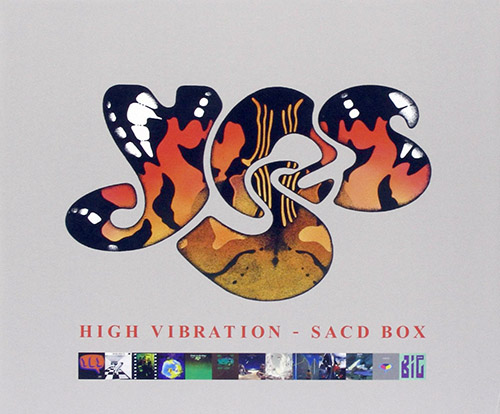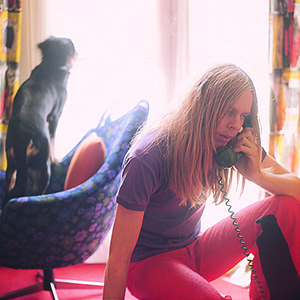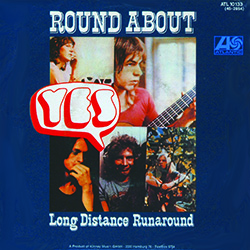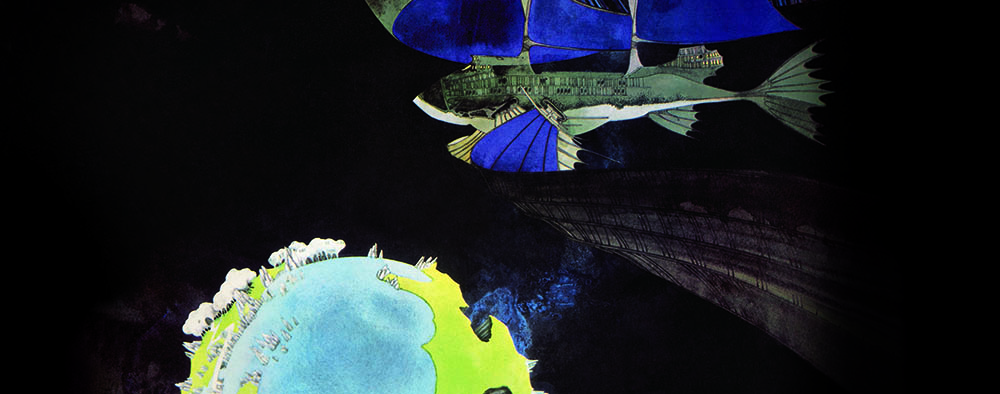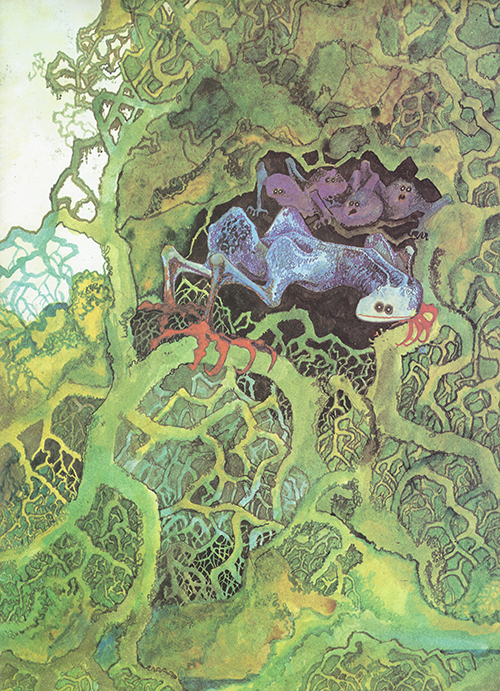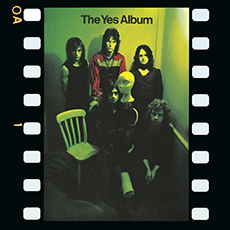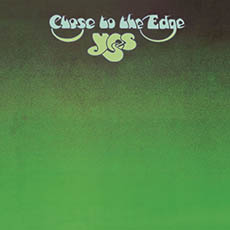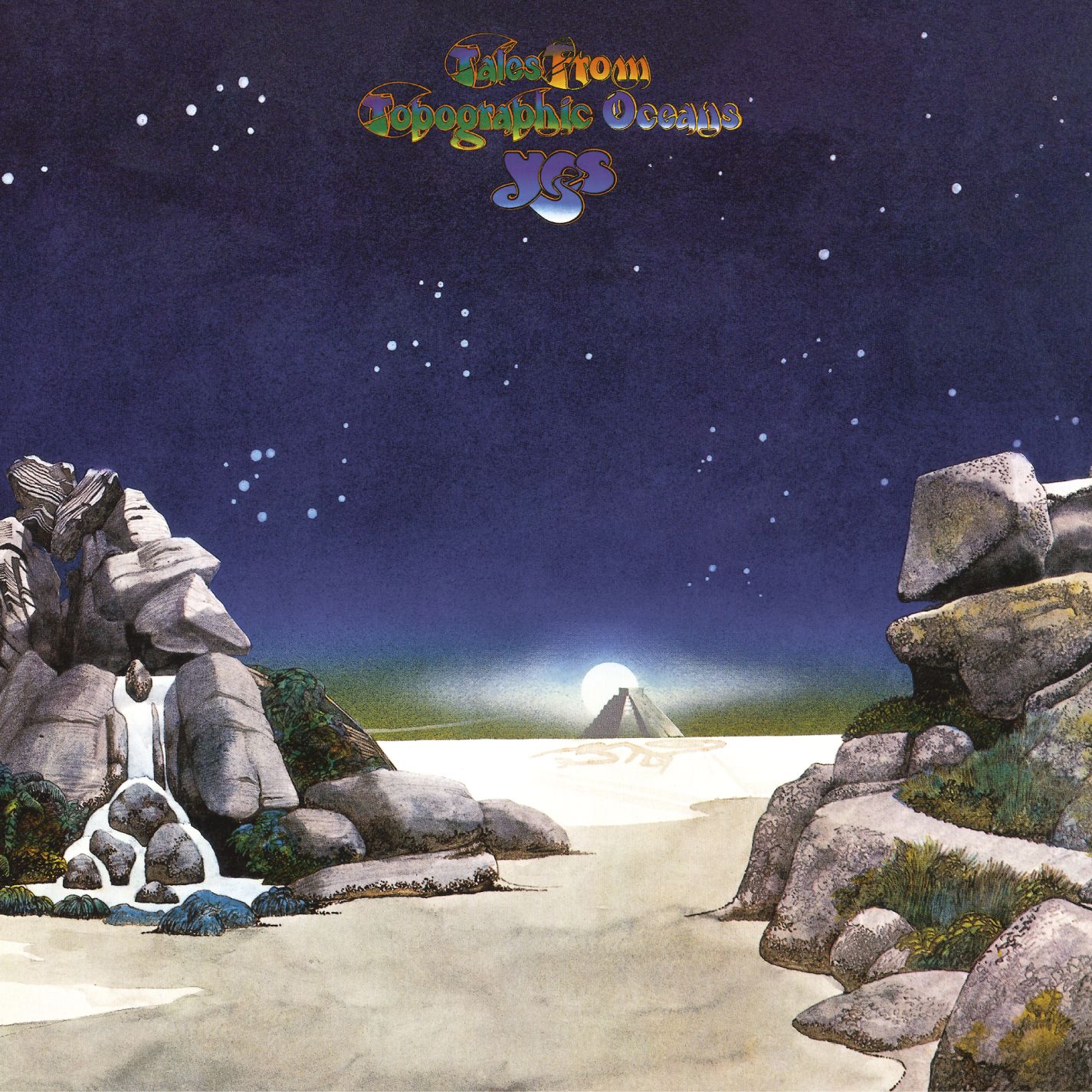
The LP’s accompanying promotional booklet contains two additional Dean paintings; the front cover depicts five creatures huddled under a root system; the back cover depicts a person climbing up a rock formation. The inside shows several photographs of the band with an individual page dedicated to each member, with smaller illustrations and photographs of their wives and children. Anderson’s page contains a short poem, while Wakeman contains a list of acknowledgements, including Wolfgang Amadeus Mozart, The White Bear pub in Hounslow, and Brentford F.C.
“Roundabout” was released as a single in the U.S. and is one of the band’s best-known songs. The album is certified double platinum by the Recording Industry Association of America for selling over two million copies.
Personnel

Vocals

Percussion

Guitars, Vocals

Bass, Vocals
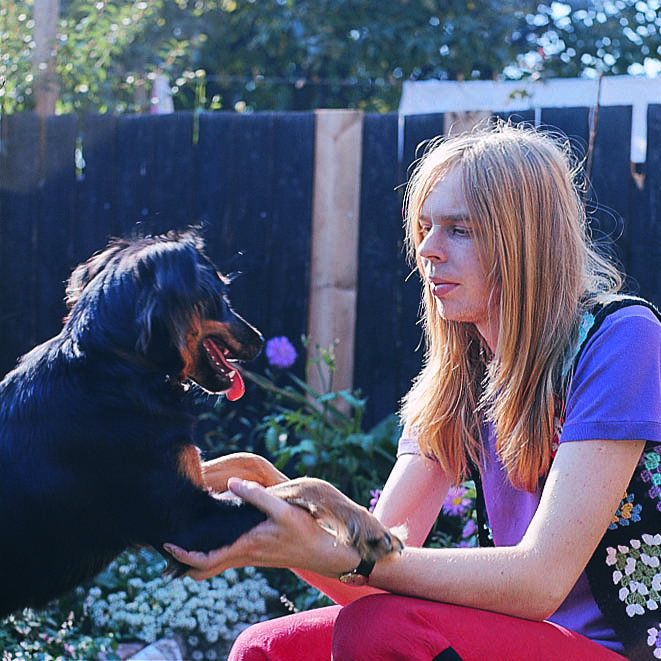
Keyboards
Recommended Versions
Steven Wilson 2013 Stereo & 5.1 Remixes for Panegyric
This is the only version of Fragile to have been completely remixed from the original multitrack tapes since 1971. In keeping with all the other releases in this series, Steven Wilson’s approach for new stereo & 5.1 mixes is to faithfully retain the spirit & sounds of the original album mix, while applying modern mix techniques to bring further clarity to the individual instrument, vocal & overdubs for each track. The songs, instantly familiar to a multitude of YES fans, remain so, with the new mixes – especially in 5.1 form – providing a greater sense of space for each voice to be heard. Anderson’s voice seems to join the listener in the room, Howe & Wakeman’s solos glisten with clarity and Bruford & Squire remind all that they were unmatched as a rhythm section during that period.
☟See Contents & Extras
– Album mixed in 24-96 5.1 DTS Lossless Surround from original multi-track sources.
– New Album mix in High Resolution Stereo
– Original Album mix (flat transfer) in High Resolution Stereo
– Six additional tracks
– Original Roger Dean artwork expanded & restored with material from the Roger Dean archive & with full approval of the artist.
– Presented as a 2 x digi-pack format in a slipcase with new sleeve notes by writer Sid Smith along with rare photos & archive material.
Extras:
– We Have Heaven (full mix)
– South Side of the Sky (early version)
– All Fighters Past (previously unheard)
– We Have Heaven (acapella) mixed by Steven Wilson
– Roundabout (rehearsal take/early mix)
– Mood for Another Day (alternate take of Mood for a Day)
About the Additional Tracks:
In addition to the main album, Steven unearthed a virtual treasure trove on the multi-track tapes, allowing him to mix full length & acapella versions of “We Have Heaven”, an earlier take of “South Side of the Sky” & – in perhaps the most exciting discovery of this series to date – a previously unheard segment of a piece now called “All Fighters Past” which incorporates ideas that would later form parts of “The Revealing Science of God” (Tales from Topographic Oceans) & “Siberian Khatru” (Close to The Edge) performed in the style of Roundabout! With a further two additional tracks – alternate takes of “Roundabout” & “Mood for a Day” & numerous exclusive to Blu-Ray edition features, including the complete album in instrumental form mixed by Steven Wilson, this is the definitive edition of Fragile.
Steven Wilson:
“With an album as well recorded and mixed as this one, the stereo remix is essentially a step along the way to the 5.1 mix and as faithful as I could make it, but it has been included in the reissue along with a flat transfer of the original 1971 mix. There are also a number of bonus tracks mixed from the reels for the first time, including a remaining fragment of song given the title “All Fighters Past” which incorporates themes later used in Roundabout, Siberian Khatru and The Revealing Science of God. This was found at the end of a reel that had been reused for a later session, but fortunately not completely erased.”
Extras for BluRay Edition only:
– Full album instrumental mixes by Steven Wilson
– Two additional alternate takes
– A full album needle-drop of an original UK vinyl pressing
– US promo singles edits as needle-drops.
☝ Hide Contents & Extras
Dan Hersch & Bill Inglot 2003 Stereo Remasters for Warner Music UK/USA
Available as:
HD 24-192 or 24-96 Downloads at HiRes Audio
Gatefold CD at Amazon
Vinyl LP as per original release at Amazon
MP3 Downloads at iTunes (Standard Edition, Mastered for iTunes), iTunes (Deluxe Edition), 7 Digital
Streaming at Apple Music, Spotify, Deezer, Tidal
The Box Set contains the following remastered albums with bonus tracks: Yes, Time and a Word, The Yes Album, Fragile, Close to the Edge, Tales from Topographic Oceans, Relayer, Going for the One , Tormato, Drama, 90125, Big Generator. Each individual album comes in a gatefold sleeve that replicates the original LP packaging.
Isao Kikuchi 2013 Stereo Remasters for Warner Music Japan
High Vibration is a 16 x Hybrid SACD Box Set made for the Japanese fans, containing their first 13 albums on 15 discs plus a bonus disc of extra tracks. All Remastered by Isao Kikuchi at 24-96 & 16-44.1 with a 220 page book in Japanese.
Albums: Yes, Time and a Word, The Yes Album, Fragile, Close to the Edge, Yessongs, Tales from Topographic Oceans, Relayer, Going for the One , Tormato, Drama, 90125, Big Generator and a Bonus Disc.
Bonus Disc: Something’s Coming, Dear Father, Roundabout (Single Edit), America, Total Mass Retain (Single Version), Soon (Single Edit), Abilene, Run Through The Light (Single Version), Run With The Fox, Owner Of A Lonely Heart (Move Yourself Mix), Leave It (Single Remix), Big Generator (Remix).
Listen
Spotify
Dan Hersch & Bill Inglot 2003 Stereo RemastersABOUT FRAGILE

– Jon Anderson
(from the sleeve-notes)
With Fragile – the fourth album by YES, Jon Anderson’s wish was fulfilled. Recorded in September 1971 following rehearsals a month earlier YES was, by this point, on something of a roll. The Yes Album had been a chart success in the UK & had started to make inroads in the US album charts following a highly successful tour there. The challenge – to take the band to the next level of success – had to be met quickly to build on that momentum. The Yes Album was both the peak & natural end point of the first period of YES album recordings.
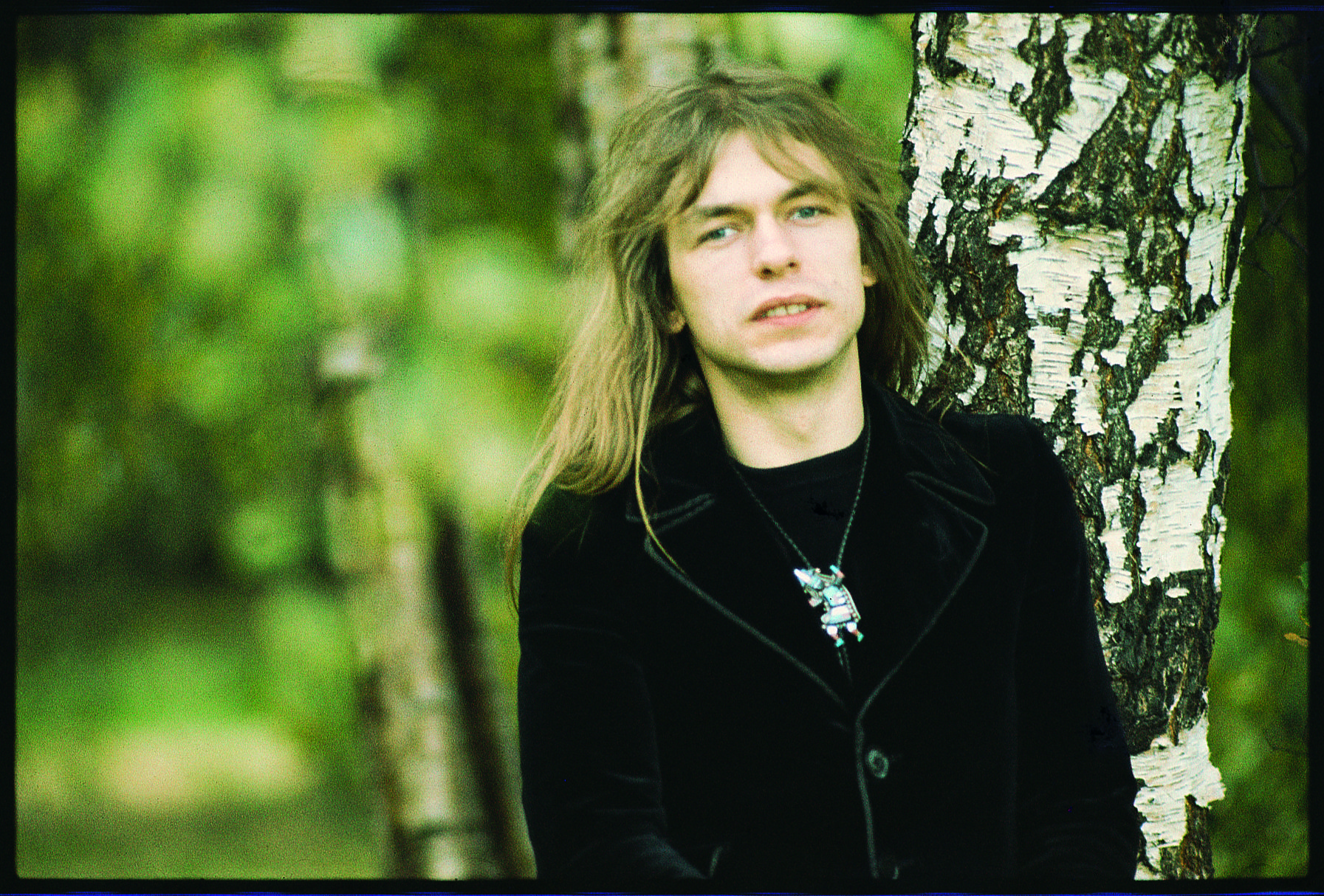
It had marked the arrival of Steve Howe, the expansion into long-form material & with a final date at London’s Crystal Palace Bowl, the departure of keyboardist Tony Kaye.

His replacement, ace session player & Strawbs member, Rick Wakeman, completed what came to be regarded as the first classic YES line-up. Wakeman brought with him an expanded array of keyboards, including a Moog synth & Mellotron & proved every bit as strong a soloist & arranger as Steve Howe. With this line-up, YES was ready for the big league.

Tracks such as “Roundabout” & “Heart of the Sunrise” have rarely been out of the live set-list & the album was performed in full by YES in venues worldwide in recent years to unanimous standing ovations.

A Brighter Shade Of Green - by Bill Martin
A Brighter Shade Of Green
YES began a period of perpetual change with The Yes Album; with Fragile they produced one of the masterpieces of progressive rock and became popular all over the world.
Two words describe much of Fragile‘s music: jagged and luminescent adjectives seldom found together. Even if the seeds of The Yes Album can be found in the band s first two records (Yes and Time And A Word), and the seeds of Fragile can be found in The Yes Album, each represents a qualitative leap. Each reminds us that there was a period, in the late ’60s and early ’70s, when a handful of rock acts went from strength to strength. Inspired by The Beatles, especially, and having their ears open to the whole world of music, these groups created new possibilities in rock, and some, of course, claimed to have left the genre altogether.
Melodically, harmonically, rhythmically, and in tonal range and colours, everything in the music had to take account of this leap in the role of what many regard (if they regard it at all) a “background” instrument.
Luminescence, but, within that, darkness. Jagged, and yet somehow liquid. The three longer works – “Roundabout,” “South Side Of The Sky,” and “Heart Of The Sunrise,” – exemplify these qualities with great depth and craft.
Yes has many “sleeper” songs, from “A Venture” (The Yes Album, 1971) to “To Be Over” (Relayer, 1974) to the more recent “Footprints” (Keys To Ascension 2, 1997). “Long Distance Runaround” is also a little gem, where a single idea unfolds perfectly. Fragile is built around four group and five solo works, of which Steve Howe’s “Mood For A Day” and Chris Squire’s “The Fish (Schindleria Praematurus)” especially stand out. The former is a warm and delicious classical guitar work that has since become part of the instrument’s basic repertoire. The latter track opened possibilities for “symphonies of bass guitars” (here echoing the title of Stravinsky’s work for wind instruments) that still need to be pursued.
The album closes with “Heart Of The Sunrise,” a study in dynamic contrasts that runs the gamut from “21st Century Schizoid Man” – inspired furious charging to dreamy pastoralism of the sort that can only come from feeling “lost in the city.” The song is a fine work in itself, but it’s also an appropriate elaboration of the green language into which Yes entered ever more deeply – a language of English romanticism, of William Blake especially, against the background of and attempting to speak with the counterculture of the time. “Ten true summers” have passed three times over since we first heard this significant musical statement, but time has not diminished its power or necessity.
– Bill Martin
Bill Martin is the author of numerous books on music and political philosophy, including Music Of Yes; Structure And Vision In Progressive Rock (1996). His essay “Another Green Language: Still Yes After All These Years” appeared in Elektra/Rhino’s boxed set In A Word: Yes (1969 – ). He is a professor of philosophy at DePaul University, Chicago.
2015 Steven Wilson Remix Liner Notes by Sid Smith
Early August, 1971: It was a little after 3am, and Rick Wakeman had just slammed the phone down on Chris Squire. The bassist, recently returned from an American tour where YES had been supporting Jethro Tull, had offered a job with the group following their decision to fire co-founder Tony Kaye. Having just finished a gruelling three-day session playing piano and keyboards in various London studios, not to mention his ongoing work as a member of rising folk-rock act Strawbs, the very last thing on Wakeman’s sleep-deprived min was jumping ship to join another group.
“I was furious,” Wakeman would later comment. Of course, YES weren’t about to take his irritable and unambiguous “No!” for an answer.
Given his formidable powers as an arranger as well as a high profile player with a growing reputation as an on-stage showman, Rick Wakeman was the obvious choice to help push YES to the next level. After the band persuaded an initially reluctant Wakeman to attend a rehearsal, by the second week in August he had joined them at Advision to work on their fourth studio album. Reflecting upon what has become referred to as YES‘ revolving door policy towards its personnel, Bill Bruford observes: “It sounds harsh but you were always looking for the better guy. Tony had given his best but it was a fast moving world and you had to give more than your best. From Jon’s point of view, Tony was committing the cardinal sin of not bringing in new technology and not bringing in enough stuff. There was one band with Peter Banks and Tony Kaye and there was another band with Steve Howe and Rick Wakeman, and they were qualitatively different. Jon wanted a small orchestra, so you put Rick together with Steve and you really do have a small orchestra overnight. I can see why Jon had to go there. It wasn’t me that initiated it but it wasn’t me also that said to Jon ‘you can’t do that’. We trusted Anderson’s vision.”
Something inspired and inspiring is exactly what Anderson got. Within the first week, ‘Roundabout’ and ‘Heart of the Sunrise’, were largely in place.
“Rick coming into the group made us work faster and harder than we’d ever done before.”
For his part, Wakeman was astonished at the level of intricate discussion and practical trial and error that went into YES‘ music. Coming from a background of session work where brevity and economy were more often than not the order of the day, he initially regarded the band’s approach to be inordinately detailed to the point of obsession. “At the end of the day after all those hours put into the little bits, then you listen back to some of the tracks you realise that it is those little attentions to detail that make the pieces what they are.”
In hindsight, restricted access to Advision was perhaps something of a blessing in disguise. It allowed Wakeman to honour his pre-YES session commitments, and enabled the rest of the band to continue prefabricating sections of material which could then be gradually assembled upon their return to Advision. “Rick would often overdub later because he was busy with sessions,” recalls Steve Howe. “We did a bit of work and then added Rick to it and that seemed to work for everyone. Chris spent hours working with Rick developing how that music would be performed. There were bits where Rick played with Chris and Bill and I dropped out in places, like in the middle of ‘South Side of the Sky’, I didn’t need to play anything – so I didn’t.”
Howe’s point regarding the intense focus upon the structure and design of each piece is borne out in the early working version of ‘South Side of the Sky’, heard for the first time in Fragile’s 2015 release featuring Steven Wilson’s remix. Breaking away from the gently converging vocal harmonies, Howe’s folkish interlude sets up space for a nimble Wakeman solo. While pleasant in itself, that they ultimately dropped the section, opting instead to maintain a more subdued mood, highlights the band’s rigorous, sometimes exhaustive and exhausting approach.
Though there’d been discussions that the next record from YES should be a double album with one studio disc and an accompanying live recording, the idea was shelved once they decided to present all new material reflecting the changes in the line-up. However, as the days ticked by during August, it was apparent they weren’t going to have enough songs to fill both sides of a single album, never mind a double LP.
Notwithstanding the undeniable strengths of ‘Roundabout’ and ‘Heart of the Sunrise’ that were now in the can and with ‘South Side of the Sky’ acting as a kind of fulcrum between the two bookends, even with Wakeman’s galvanising presence, the meticulous but laborious means by way which YES wrote, arranged and assembled their pieces simply couldn’t generate the required tracks in the time they had left.

Rick Wakeman wasn’t the only person to become a member of the extended YES family during the recording of Fragile. Although he had produced covers for other bands and labels, Roger Dean’s work on Fragile not only established him as one of the quintessential artists of his generation at the age of 26, but initiated a creative partnership with the band that endures to this day. “I was very excited to be working on a project with such interesting music,” says Dean of the start of their association.
“Bands like YES really opened the door to an appreciation of music that was way wider than the rock’n’roll that I loved. People used to say to me ‘weren’t YES really pretentious?’ But that isn’t how they did it. They didn’t try to be clever; they just were very clever musicians and they wanted to play to the very limit of what they could do. It was just natural for them. It wasn’t being pretentious – it was the sheer joy in performing at the edge.“
Dean’s simple but evocative artwork, with its expansive suggestions of mankind pushing out towards the frontiers and extremes of both inner and outer space, found its echo in Anderson’s opaque lyrics which sought, in part, to address his unfolding search for spirituality and meaning in a fraught and turbulent world.

If The Yes Album consolidated the band’s position in Europe, it was Fragile that signed, sealed and delivered the all-important American market. With a surprise hit single version of ‘Roundabout’ dominating FM radio, and the happy synchronicity of their fourth studio album peaking at No.4 in the US album charts in January 1972, YES had well and truly arrived. That they had achieved this feat of tenaciously going forward without a backward glance, of pursuing their artistic vision through a commitment to change and grow as players in less than six months together, is nothing short of astonishing.
The death of Chris Squire in 2015 reminds us how fragile life can be and of course makes the 2015 edition of the album all the more poignant. Squire often stated that Heart of the Sunrise was among his favourite contributions to YES. His playing from that opening roar, down to the interplay with Bill Bruford’s drumming, and climbing back up into the main theme again, distills all the aspects to Squire’s approach: tough, deft, economic, lyrical and, above all, intense. The fact that he was just twenty three years old when he did it makes this album all the more remarkable.
Sid Smith
August 2015
Whitley Bay
Sid Smith is a freelance writer featured in Prog. Classic Rock, BBCMusic, Q, Record Collector etc. He is the author of rock music biographies as well hundreds of sleeve notes for reissues and new releases. You can find out more by visiting sidsmith.blogspot.co.uk
Lyrics
Roger Dean's Additional Artworks
Rick Wakeman's Acknowledgements
A note from Steven Wilson about his 'Definitive Edition' YES Album Remixes

Since the advent of CD in the early 80’s, all the 60’s and 70’s YES albums have been remastered for the different editions by various mastering engineers. Each time this remastering process broadly involved taking the mix from the same original Eddy Offord stereo master tape and applying different amounts of EQ and compression to it. This means that if the mastering engineer decided that the bass guitar needed more bottom end then he/she had to add bass across the whole track, therefore affecting other elements in the mixes too. Additionally many of these reissues have been subjected to mastering compression to make them sound louder and in theory more “exciting”, but at the expense of the natural dynamics of the recording. For a band like YES where there is so much subtlety and dynamics in the music this “ear-fatiguing” approach would seem to be wrong to me.
Remixing, on the other hand, entails a more sophisticated and time consuming process – going back to the original 16 or 24 track multitrack session tapes, and then recreating the mix from the drums up. Applying EQ to each individual instrument (rather than across a whole mix), rebalancing, recreating echo, reverberation, phasing and other effects, making volume moves, positioning elements in the stereo spectrum, and more. In doing this, since we now have the ability to work with the latest high resolution audio tools, it allows for greater clarity between instruments to be achieved. No additional compression has been added at all. The remixes may seem quieter, and you may have to turn up your stereo, but that is because all of the natural dynamics have been retained.
That’s not to say that this means these new mixes are “better”, because particularly the original mixes of albums such as The Yes Album, Fragile, and Close to the Edge are brilliant. So if you are intimately familiar with them the new versions may sit uncomfortably with you, no matter how faithfully I tried to stay close to the originals. But if you treat the new mixes as an alternate perspective, you may notice additional details you hadn’t before, and more importantly the new stereo mixes are a step along the way to creating the 5.1 surround sound mixes. (Note that if you just can’t get on with the remixes, then the original mixes are also included in these reissues for the first time as high resolution flat transfers, so none of that added mastering EQ or compression, exactly as they left the studio after Eddy had mixed them).
Additionally returning to the archives gave me a chance to mix unreleased material from the multitrack session tapes for the very first time – either things that the band had originally recorded but abandoned prior to mixing, alternate takes, or different perspectives of the album takes (such as the instrumental mixes, or the a cappella mix of We Have Heaven from Fragile).
I hope you enjoy the definition and clarity of these new mixes in high resolution 96/24 audio, and of course especially in 5.1 surround sound where these classic albums really open out and shine!
Steven Wilson
YES albums available in Steven Wilson Definitive Editions
Get the Definitive versions of 5 Classic YES Albums on Amazon: The Yes Album, Fragile, Close To The Edge, Relayer and Tales From Topographic Oceans.
Remixed & Remastered by Steven Wilson in HD24-96 5.1 & Stereo, and also including the original YES/Eddy Offord mix, with a host of extra tracks.




